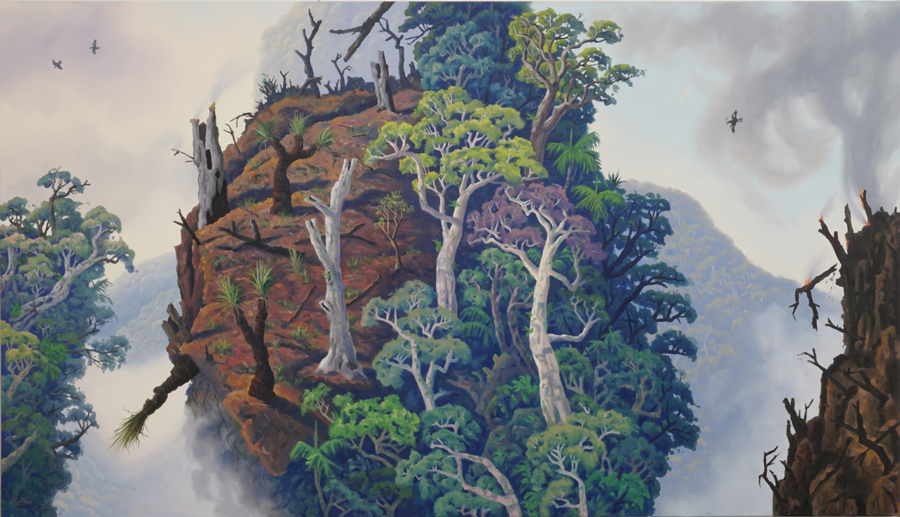
An artwork created through the Regeneration Creative Bushfire Recovery Project. Image via Scenic Rim Regional Council Facebook
In the thick of the bushfires of 2019’s Black Summer, Beechmont resident Jessica Brown had fires reach her back gate, with 11 homes on her street Timbarra Drive razed, many of which belonged to her best friends who have not since returned to the area.
Despite not losing her home, she describes a feeling of rawness from losing a sense of safety in her home, and feelings of helplessness and disconnection from friends and family.
Coming out of a desire to reconnect with families in the area, she started The Little Pocket – a gathering place for families to meet weekly to connect and let their children play in the nature space that features a mud kitchen, fire pit for fire safety education, and a story tree.
Two months after the fires, a community day was held at The Little Pocket called Regeneraton Day, aimed at bringing neighbours together to connect and laugh.
“We cried, people read poetry, it was really beautiful,” Jessica told the Creative Recovery Network.
“At that day we had three interactive art activities happening – we had a canvas where people repainted the forests that have been lost. People repainted their favourite tree.
“We had poetry where people were invited to write things they were grateful for… and we had a 'leave now' installation where we had little tags and people wrote down what it was that they packed.”
After the day was over, the organisers of the day sat down and discussed what a success it had been, devising a plan to build on it.
“That’s where the seed was planted and we just carefully nurtured that over the last two years to become the Regeneration Creative Bushfire Recovery Project,” Jessica said.
The organisers formed an advisory group – the Advisory Group for Regeneration – and landed on four key projects that they believed would best support each other and the community – a mural project, an exhibition, a publication and a documentary.
The next step was securing support from Council.
“The Scenic Rim Regional Council has been fabulous and their support has been amazing,” Jessica said.
“Bronwyn Davies, who’s part of the cultural team there, has been an absolute champion in this project.
“So she actually was, I guess you could say, like the catalyst of this actually getting legs.”
Bronwyn joined the Advisory Group for Regeneration and encouraged Jessica to put together a project plan to submit to Council for funding.
“I think it was just the synergies of putting the right people together in the right room and just watching Jess bloom and the community bloom and get behind this project and have a focus that wasn’t all doom and gloom,” Brownyn said.
“I think that’s been a really important part of it.
“I think for me, community-led projects in a recovery or disaster context mean that they come from the community itself. They’re not imposed upon the community.
“From our position we work hand-in-hand with that, with the communities when they’re going through a disaster.
“We’ve had floods, cyclones, fires and droughts, so we are fairly aware of the situation and the issues. But you can’t impose your will of what you think is the right thing on a community that’s going through a disaster situation.
“What we will try to do is provide a platform for those in the community who are of a mind to do something, to find a way to support them to do that with their community, so it’s reflecting the voice of their community.”
Jessica’s submission to the Scenic Rim Regional Council was approved for two years of funding support through the Category C Community Recovery Funds, supported by the Beechmont Country Women’s Association. It was supplemented through various other funds including the Gold Coast City Council discretionary grant.
Since receiving the grants, the Regeneration Creative Bushfire Recovery Project has accessed Creative Recovery Training to better prepare them for working with trauma-impacted members of their community in a safe and productive way.
The Regeneration Project is now in full flight with many community members working across projects including the exhibition, which was recently opened, the documentary, and a host of arts projects that have had meaningful impacts on helping community healing.
Councillor Virginia West says empowering community members to lead their own recovery is the best approach.
“… generally, I believe the community want to do things themselves,” Cr West said.
“They just want a little bit of help along the way. And once they get cracking, that’s it, they don’t want council to be doing it all for them, but they want council to be alongside them … and that’s how I see our role really, to be there if we’re needed, but to encourage them to do this for themselves.
“Because I believe that is much more powerful and that’s what we’re here for is to empower our communities.”
She said exposure to the project has also given her a much greater appreciation for art and culture in the recovery realms.
“It’s certainly brought people together as a group,” Cr West said.
“I know, especially when we first started, there was still a lot of emotion there that has to be dealt with and everybody was very supportive of each other.
“I don’t know that governments of any stripe have actually fully realised the power and capacity of the arts to harness cohesion in that space.
“I think a very forward-thinking council would definitely embed the arts in all their disaster management plans and all levels of strategic planning.”